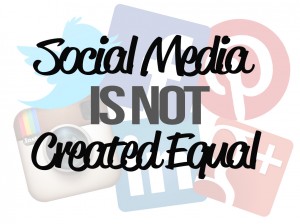All Social Media Is Not Created Equal
Do You Need to Adjust Your Social Media Strategy?
 I’m going to assume that you already know that all social media is not created equal. Tweeting is not like updating your status on Facebook. Posting an image to Instagram isn’t the same as pinning. So why do companies think that their social media strategy doesn’t need to differentiate how they approach different channels?
I’m going to assume that you already know that all social media is not created equal. Tweeting is not like updating your status on Facebook. Posting an image to Instagram isn’t the same as pinning. So why do companies think that their social media strategy doesn’t need to differentiate how they approach different channels?
Choose the Channels That Are Right for You
The first thing to focus on is which social media channels your company should be utilizing. No matter what you decide do with your social media, there are necessary steps that cannot be neglected. You must do your research, benchmark against competitors, and be sure you’re following industry best practices to ensure that you’ve chosen the right channels.
Maybe you only have the manpower for three social media channels, and you run a company that sells lotions—the best for you would likely be Facebook, Twitter, and Pinterest. I recommend these three because Facebook and Twitter have huge followings and likely contain large numbers of your target market, and Pinterest’s main audience is women who pin things relating to beauty, food, exercising, and cute animals, so you could get traffic to your site by pinning your lotions. As a smaller business, trying to keep up with certain social medias may prove difficult (Instagram, Vine, Google+, LinkedIn, it’s different for every brand), because you won’t be able to focus on these platforms or generate that much in terms of leads or community. Don’t spread your efforts too thin.
With that in mind, it could be helpful to send out a survey to gain insight into what social media channels your target market is using. Don’t make the mistake of thinking you can be successful without knowing your audience—it just won’t work.
But if you can handle taking on more social media that will be effective for your company, jump on in (after you create a strategy, that is). If you are consciously strategizing and using social media the way that it was intended, success is on the horizon.
Create a Strategy for Each Social Media Platform
Once you’ve chosen the channels that you want to use or are already using to build a community, set a strategy in place. If you already have a strategy in place, now is the time to reevaluate. When it comes to branding, there should be a consistency across your channels—if someone is regularly engaging on your Facebook page and one day they hop over to your Twitter, they should immediately know that it is yours (color scheme, logo, voice should be similar).
Outside of the branding consistencies, it’s important to differentiate your strategy based on the atmosphere of each channel. Does your strategy focus on each individual social media channel and treat them as their own separate identities? If not, it should. Your strategy should focus on voice, posting frequency, response and engagement, and posting guidelines. For example, it’s probably appropriate to say “hahaha” about a funny animal pin on Pinterest, which is lighter and more image-oriented, but not so much on LinkedIn, which is all business. Each social media channel has a different audience, and each audience wants something different.
Begin posting, or if you already have a strategy in place, adjust your posting. Familiarize yourself with how to best optimize your profile for each social media platform. Maybe try out some new tactics on your social media and see how they’re received. See what works best for you.
Analyze Your Results for Each Platform
Keep in mind that it takes time, effort, and consistent work with social media to make a change. Be patient with your social media, and keep posting and engaging with your audience and community.
But is your strategy working? Take a look at your analytics (both for your website and for your social media) to see which posts are getting the most results, which blogs are generating the most interest, and if sales have gone up since you’ve implemented the new strategy. Adjust accordingly. You can do this using Google Analytics to see how your social media channels are impacting your website, and you can use the analytics tools provided by sites like LinkedIn and Facebook to see how those sites are performing on their own.
The important thing to remember is that social media doesn’t stay the same way for long, and platforms are constantly changing (do you even remember what Facebook looked like three years ago?). Always be ready, willing, and able to adjust, and always be on the lookout for ways to make your social media channels more impactful.
Vanessa Levin-Pompetzki—Digital Media Coordinator




